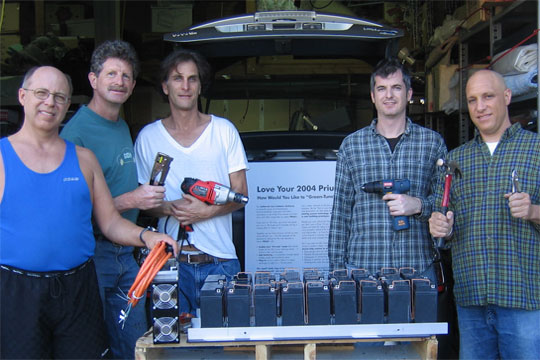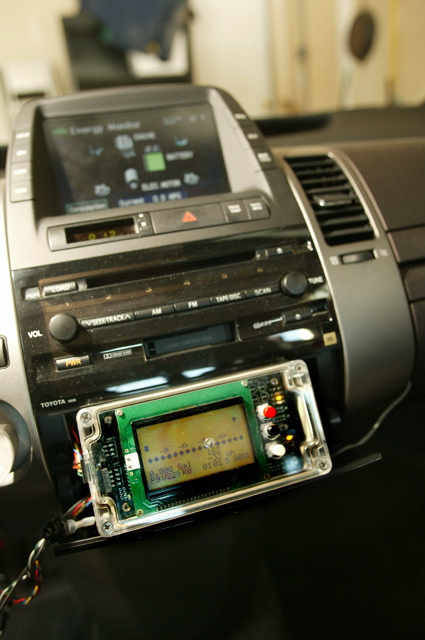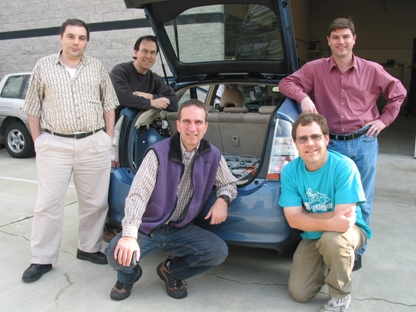SPARKY: More Plug In And Play & The Return of the L3 Enigma —
Experimental Hybrid Cars Get Up to 250 Mpg
By TIM MOLLOY, Associated Press Writer Sat Aug 13, 7:08 PM ET

Graphic explains the Toyota Prius and
talks about how some people are modifing
their cars for even better gas milage. (AP Graphic)
Politicians and automakers say a car that can both reduce greenhouse gases and free America from its reliance on foreign oil is years or even decades away. Ron Gremban says such a car is parked in his garage.
It looks like a typical Toyota Prius hybrid, but in the trunk sits an 80-miles-per-gallon secret — a stack of 18 brick-sized batteries that boosts the car's high mileage with an extra electrical charge so it can burn even less fuel.
Gremban, an electrical engineer and committed environmentalist, spent several months and $3,000 tinkering with his car. (Complete in Link)
_____________________________________
On the Net: CalCars Initiative: http://calcars.org
PRIUS+ Photos
See a 16-slide captioned presentation (800KB PDF) about CalCars and PRIUS+.To see many more photos of the CalCars prototype as it now looks, plus the pack under construction and team members, see Three PRIUS+ Albums. and photos in Jully 11 story at Wired.com -- and see media clips of the car at our Kudos page.
CalCars' proof-of-concept setup was soon surpassed by EnergyCS's and EDrive's lithium conversions, below. For specs of all prototypes, see latest version of Fact Sheet at PRIUS+. See CalCars' Vehicles page for links to photos of PHEVs from UC Davis, DaimlerChrysler Sprinter.

Toyota's "EV Button" that led to online discussions and helped inspire CalCars' PRIUS+ project. (Found in 2004 and 2005 Priuses, also in Highlander and Lexus hybrids, it's positioned to the left to the steering wheel, labelled and enabled in Asia and Europe, blank and disabled in US. It provides about a 1-mile electric only range at low speeds. If you're interested in the story, see "Information if you're technically inclined" at PRIUS+.)
 The CalCars PRIUS+ prototype's lead-acid pack -- to read labels see larger photo (145KB).
The CalCars PRIUS+ prototype's lead-acid pack -- to read labels see larger photo (145KB).
 PRIUS+ team: we built the first PRIUS+ conversion Sept 11-22, 2004, starting with a low-cost lead-acid battery pack. Pictured are (L-R) Ron Gremban, Felix Kramer, Marc Geller, Kevin Lyons, Andrew Lawton. See About CalCars for names of those who helped but are not pictured.
PRIUS+ team: we built the first PRIUS+ conversion Sept 11-22, 2004, starting with a low-cost lead-acid battery pack. Pictured are (L-R) Ron Gremban, Felix Kramer, Marc Geller, Kevin Lyons, Andrew Lawton. See About CalCars for names of those who helped but are not pictured.
 CalCars Founder Felix Kramer, Technical Lead Ron Gremban (holding our heavy-duty Brusa configurable charger) in the snows of Michigan to meet with reporter Danny Hakim for The New York Times story that appeared March 2..(Photo by Andy Sacks.)
CalCars Founder Felix Kramer, Technical Lead Ron Gremban (holding our heavy-duty Brusa configurable charger) in the snows of Michigan to meet with reporter Danny Hakim for The New York Times story that appeared March 2..(Photo by Andy Sacks.)

EnergyCS's prototype display unit for its replacement battery management system, installed in Ron's PRIUS+. Note that Prius's display works alongside it -- and future "consumer-ready" installed kits from EDrive Systems (the EnergyCS-Clean-Tech consortiium) may not ask non-technical drivers to view much beyond the standard Prius display. (Photo by Andy Sacks.)

EnergyCS battery pack: Valence Technology Saphion U-Charge large-format phosphate-based lithium-ion batteries. For specs on the pack, see latest version of Fact Sheet at PRIUS+. Photo by Greg Hanssen
![]()

EnergyCS team: Hovig Kouyoumdjian, Chris Aragon, Pete Nortman, Greg Hanssen and (rear right), Mark Kohler from Valence Technologies. Not pictured: Daniel Sufrin. Photo by Bill Moore, EVWorld.

"Before & After:" At San Francisco's Presidio, KTVU-TV camera operator compares the battery-filled under-deck compartment of Technology Lead Ron Gremban's PRIUS+ with founder Felix Kramer's stock Prius (with EV button enabled). Photo by Ron Gremban.

Greg Hanssen from EnergyCS, Seth Seaberg from Clean-Tech (EDrive Systems co-founders) with Felix Kramer from CalCars at the Clean Cities Conference in Palm Springs with the third plug-in Prius, May 2, 2005, the day EDrive announced its launch. Photo by Bill Moore, EVWorld.
_____________________________________
On the Net: CalCars Initiative: http://calcars.org
_____________________________________The L3 ENIGMA
Owners of hybrid technology vehicles might be facing a slightly brighter scenario. With the gas situation showing no signs of letting up, alternative fuel sources are offering an increasingly popular substitute to conventional gasoline-run automobiles. Asfaw Beyene, assistant mechanical engineering professor, said alternative fuels include electricity, ethanol, natural gas, propane, methanol, hydrogen and biodiesel, as stipulated in the U.S. Energy Policy Act of 1992. "According to Shell, an oil company that has a reason to be optimistic, oil will deplete in about 40 years, gas in about 60 years and coal in about 200 years," Beyene said. "The world's oil reservoir has only decades - four or five - before depletion." While electric-powered cars have received the most public attention, the United States, Japan and the European Union have taken the lead in developing a medley of other alternative-fuel vehicles, Beyene said. These include light-duty vehicles, which operate on compressed natural gas; propane; E85, a blend of 85 percent ethanol and 15 percent gasoline; biodiesel, an agricultural derivative from plant oils or animal fats; and electricity. Another form, flexible-fuel vehicles, allows for alternate re-fueling with either gasoline or E85. "The fuels power the car the same way your normal fuel does," Beyene said. Biodiesel in particular, he said, can be used in any diesel engine without modification, and is widely available in the United States including at a fueling station in San Diego on El Cajon Boulevard that is owned by Pierson Ford. "(Alternative fuel vehicles) are a long-term option," Beyene said. "More than a million FFVs (have) already been sold in the United States." But despite progress being made in clean automobile technology, the gasoline crisis shows no signs of short-term resolution. According to www.usatoday.com, President Bush's bill permitting oil drilling in Alaska's Arctic National Wildlife Refuge, fossil fuel conservation and promotion of alternative energy sources have stalled in Congress for the fourth year. Similarly, plans to tap the 600-million barrel Strategic Petroleum Reserve, which would lower the average national gas price by 20 cents per gallon, have encountered opposition from politicians who say the reserves should be kept for emergencies. |
Despite battles on Capitol Hill, proactive attempts at furthering the alternative fuel cause have reached universities across the nation.
SDSU is one of 20 college campuses participating in "Challenge X," a nation-wide project sponsored by General Motors that promotes the development of alternative fuel vehicles. GM funds up to $10,000 dollars to select universities across the nation, which compete to convert a stock sport utility vehicle into the most efficient hybrid possible.
SDSU is also home to the "Enigma," a 260-horse power, hybrid sports car developed by a team of about 15 students and faculty in the mechanical engineering department.
Headed by James Burns, assistant professor and director of Facility for Applied Manufacturing Enterprise, the Lotus look-alike Enigma boasts a mileage of up to 80 miles per gallon and is capable of 0 to 60 mph in seven seconds.
"We'll be driving the Enigma cross-country on one tank of gas, from San Diego to Daytona Beach, Florida in August," physics senior Mitch Zafer, a member of the Enigma team, said.
The result of a seven-year project, Enigma is an example of how alternative fuel sources can power vehicles of the future.
With the prospect of a depleted fossil fuel reserve nearing, a tangible network of alternative fuel sources is emerging.
Beyene said the U.S. Department of Energy has created the Clean Cities Program, which seeks the cooperation of federal agencies, state and local governments, businesses, industries and environmental and community organizations in building networks of alternative fuel stations.
Today, compressed natural gas is available in almost every state, electric recharging facilities are available in about 25 states and E85 stations are expanding from their Midwestern base, Beyene said.
"With the end of the fossil years in sight and with depressing news of exploring exotic parks such as that in Alaska, I think the next generation's transportation needs would be very familiar with, if not entirely dependent on, alternative fuels," he said.


Dr. Jim Burns (in front of) and then seated in the L3 Enigma, with San Diego State University team members. The L3 is powered by a 200 HP AC Propulsion electric drive and VW 1.2L TDi diesel engine burning 100% soybeam oil. It can do zero-to-sixty in under five seconds and has a 20 mile electric only range. Burn's goal is to drive the car coast-to-coast on just 33 gallons of B100 fuel.
SDSU Competes Against the Best to Develop a Greener SUV
 | |
|
Students and faculty from SDSU's Department of Mechanical Engineering have been chosen to participate in a high-profile three-year competition to develop a more environmentally friendly sport utility vehicle.
The competition, called Challenge X: Crossover to Sustainable Mobility, is sponsored by the U.S. Department of Energy (DOE) and General Motors. The 17 selected universities, announced at a press conference last week in Washington, D.C., will re-engineer a 2005 Chevrolet Equinox, a new compact SUV. The competitors have three basic goals: reduce energy consumption; decrease emissions; and maintain the performance and utility features of the stock model.
Jim Burns, associate professor of mechanical engineering, who will direct the SDSU team, said all of the participating universities have leading-edge programs that will provide intense competition. Settling for second, though, is not in his thoughts.
“We intend to build the best new hybrid-electric SUV powertrain – period,” said Burns, who has worked with students in recent years to develop the L3 Enigma, an award-winning, high-performance, hybrid-electric sports car.
“Many of the lessons we learned from building the L3 Enigma will be used in this new vehicle. We also have some new tricks up our sleeve that are going to continue to surprise and please both the driving public and the program sponsors.”
The first year of the competition will focus on modeling, simulation and testing of the powertrain and vehicle subsystems. The most promising approaches will receive funding and hardware in the second and third year to incorporate the advanced designs into the Equinox.
Students will use General Motors’ real-world methodology for managing, designing, building and testing their Challenge X vehicle. They will have a hands-on opportunity to work with the latest automotive propulsion and emission control technologies, fuels and materials. The competition will be managed and evaluated by the Argonne National Laboratory, a DOE research and development facility.
“This is a wonderful way to get our students involved in solving real problems,” said David Hayhurst, dean of SDSU’s College of Engineering. “They’ve been given an opportunity to work with some very elite people and institutions. The experience they will gain from this project will be tremendously valuable as they head into industry.”
Burns expects several dozen students per year will have the opportunity to work on the Challenge X project. “Work has already begun on the conceptual design,” he said.
David Garman, acting undersecretary for the Department of Energy and the DOE’s assistant secretary of energy efficiency and renewable energy, said the efforts of the Challenge X students may one day pay huge dividends for the country.
“Advanced vehicle technology competitions such as Challenge X demonstrate pathways which ultimately could help reduce our dependence on oil,” Garman said. “Reducing petroleum use is vital to our nation’s long-term energy security.”
Other teams participating in the competition are: Michigan Technological University; Mississippi State University; Ohio State University; Pennsylvania State University; Rose-Hulman Institute of Technology; Texas Tech University; University of Akron; University of California, Davis; University of Michigan; University of Tennessee; University of Texas at Austin; University of Tulsa; University of Waterloo; University of Wisconsin, Madison; Virginia Tech; and West Virginia University.
More information on Challenge X is available at www.challengex.org.


0 Comments:
Post a Comment
Subscribe to Post Comments [Atom]
<< Home